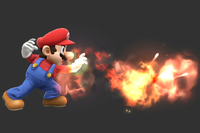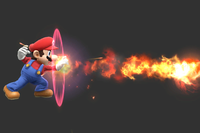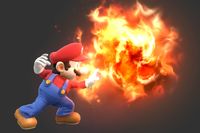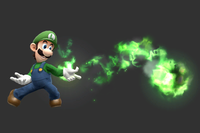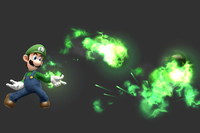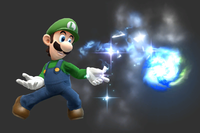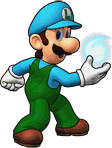Fireball
| Fireball | |
|---|---|
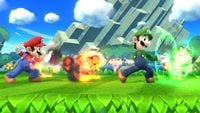 Mario and Luigi throwing Fireballs in Super Smash Bros. for Wii U. | |
| Users | Mario Luigi |
| Universe | Mario |
| Article on Super Mario Wiki | Fireball |
| “ | Shoot bouncing balls of fire horizontally. They vanish as they slow. | ” |
| —Melee's instruction manual | ||
| “ | Shoot a bouncing fireball that disappears once it loses speed. | ” |
| —Brawl's instruction manual | ||
| “ | Shoot fireballs from your palm. | ” |
| —Smash for 3DS's foldout (Mario) | ||
| “ | Shoot a fireball that flies straight ahead. | ” |
| —Smash for 3DS's foldout (Luigi) | ||
Fireballs (ファイアボール, Fireball) are small projectiles launched by Mario and Luigi as their neutral special moves. Each travels a short distance, does minor damage, and causes flinching common to fire-based attacks. The fireball's trajectory changes according to the stage's surface angle upon contact, though with different results for each character.
In Super Smash Bros., both Mario's and Luigi's fireballs do 7%, while in Super Smash Bros. Melee, their damage is decreased by 1%, only causing 6%. In Super Smash Bros. Brawl, Mario's fireball does 5% while Luigi's does 6%. In Super Smash Bros. 4, Mario's and Luigi's fireballs do less damage the further they travel; 5% close, 4% far for Mario and 6% close, 5% far for Luigi.
Fireballs were initially larger in Super Smash Bros., but their size decreases in Melee, then they are slightly larger in Brawl. As with all standard specials, Kirby can also use Fireball after inhaling either brother.
Users
Mario
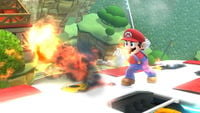
Mario's red fireballs fall to the ground, losing momentum with each bounce. As such, they are more effective when fired from higher locations and toward downward slopes, traveling further. When firing at a wall or upward slope, the balls will bounce backward, a more defensive maneuver for brief protection from oncoming foes, perhaps in the air or from behind. Mario's fireballs can be spammed, though with some difficulty (and at a slower rate of fire than Luigi's), and are a decent approach tactic. The move can be more efficient when used in the air, falling to meet the enemy at ground level, while still moving, and negating lag.
In Super Smash Bros. 4, Mario's Fireballs are more realistic, with smoke and ashes coming out of the flames. Due to the addition of custom movesets, the attack can also be changed into Fast Fireball or Fire Orb.
For his animation since Melee, Mario brings back his left/leading hand and palms it forward to release the projectile.
Luigi
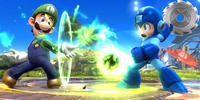
Luigi's green fireballs travel in a straight line and are unaffected by gravity (matching his floaty motif) and drift around in a circle, rather than rolling like Mario's. Also, despite the fact Luigi's fireballs are green, they still make red-orange burn animations upon impact on a character. They can be easily spammed, and can be fired at a slightly faster pace than Mario's, especially in the Negative Zone (Luigi's Final Smash in Brawl). When firing at stage elements, the projectile's path will change based on the contact angle. As such, the move is more useful when used toward upward slopes, continuing on to foes. The move is more difficult to use on downward slopes, passing over enemies. Fireball approach is perhaps more difficult than with Mario, as the attack does not fall when used in the air. In general, Luigi's special attack is contextually less useful than Mario's, as it only travels in only one direction (forward), where Mario's move in two (forward, and downward). It also travels less distance. Luigi's fireballs deal 1% more damage than Mario's.
In Melee, using Fireball while wavedashing off from a platform preserves his horizontal momentum, allowing him to travel the stage relatively quickly. This technique is called a Vududash, after the smasher Vudujin.
For his animation since Melee, Luigi brings back his left/leading hand in a covering position and gestures it forward in a finger snap to release the projectile.
Customization
Special Move customization was added in Super Smash Bros. 4. These are the variations:
Mario
| 1. Fireball | 2. Fast Fireball | 3. Fire Orb |
|---|---|---|
| "Throws a fireball that bounces on the ground." | "Throws a faster, slightly weaker fireball straight ahead." | "Throws a big ball of fire. Slow, but hits repeatedly before disappearing." |
- Fireball: Default.
- Fast Fireball (高速ファイアボール, High-Speed Fireball): Travels directly forward at high speed, but does not cause knockback and inflicts less damage. The fireballs are also about half the size.
- Fire Orb (巨大ファイアボール, Giant Fireball): Is much larger, moves slowly in an arc, and does not disappear upon hitting an enemy, allowing it to hit foes more than once which can be useful for follow-ups. However, its startup lag and ending lag are both much higher.
Fast Fireball in Super Smash Bros. for Nintendo 3DS
Fire Orb in Super Smash Bros. for Nintendo 3DS
Luigi
| 1. Fireball | 2. Bouncing Fireball | 3. Ice Ball |
|---|---|---|
| "Throw a fireball straight ahead. It will bounce if it hits a wall or the ground." | "Throw a fireball that bounces along the ground. Gradually loses power." | "Throw a slow-moving, icy ball at your foes." |
- Fireball: Default.
- Bouncing Fireball (バウンドファイアボール, Bound Fireball): Allows Luigi's fireballs to bounce on the ground, acting much like Mario's. The fireballs do less damage each time they bounce, in addition to reducing bounce height. Has slightly more ending lag.
- Ice Ball (アイスボール, Ice Ball): Moves slowly, but possesses a longer range and has a chance of freezing enemies with high damage percentages. Has slightly more start-up lag.
Luigi's Bouncing Fireball being used in Super Smash Bros. for Nintendo 3DS
Luigi's Ice Ball being used in Super Smash Bros. for Nintendo 3DS
Origin
Fireballs were introduced in the game Mario Bros. Red and green fireballs would periodically travel across the screen as hazards. The red fireballs moved in a random pattern, being affected by gravity, and the green fireballs moved in a straight path, not being affected by gravity at all. Only the green ones appear in Brawl's version of the stage, but they start out as red/purple before moving. They can be destroyed for points with Mario and/or Luigi bumping them from underneath with a jump should they be close enough to the platform above.
Although fireballs appeared in Mario Bros., the act of shooting fireballs originated in the 1985 game, Super Mario Bros., where the ability was obtained after collecting a Fire Flower. The power is lost when the player dies or takes damage. In the game, fireballs were small, traveled very quickly, and did not stop until hitting something. Also in this game, and other traditional Mario games, Luigi's fireballs are not unique, being red in color and behaving exactly like Mario's. In most games, only two fireballs could be on-screen at a time even if one could be rapid-fired after another. Luigi's green fireballs made their debut in the Super Smash Bros. series, but reappears later in the Mario spin-offs such as Mario Kart: Double Dash!!, Mario Superstar Baseball, Mario Hoops 3-on-3, Mario Super Sluggers, Mario Sports Mix.
A Fire Flower would also change the character's clothing colors, depending on the game. Usually, Mario's overalls became red, while Luigi's turned green, both with white shirts and caps. These color schemes are available as alternate costumes for Mario and Luigi in Super Smash Bros. Brawl and Super Smash Bros. 4.
The ability for Mario to use fire without a Fire Flower is a reference to Super Mario RPG: Legend of the Seven Stars. In the game, Mario had the ability to use fire-based attacks (without using a Fire Flower), such as Fire Orb, Super Flame and Ultra Flame.
One of Mario's custom moves, Fire Orb, possesses the same name and a similar appearance as one of his special attacks from Super Mario RPG: Legend of the Seven Stars, but it functions differently from the attack in that game. Also, one of Luigi's custom moves, Ice Ball, is based off of Ice Luigi from New Super Mario Bros. Wii and New Super Mario Bros. U.
Gallery
- Fireball (SSBM).png
Mario and Luigi's Fireballs in Melee.
Mario's Fireball in Super Smash Bros. for Nintendo 3DS.
Luigi's Fireball in Super Smash Bros. for Nintendo 3DS.
Mario's Fireball in Super Smash Bros. for Wii U.
Luigi's Fireball in Super Smash Bros. for Wii U.
See also
Trivia
- In Smash 64, at one very specific point in the move just when Mario throws the Fireball, his character model will turn completely red. This lasts for only a few frames. The same thing applies with Luigi.
- In SSB4, upon Mario's Fireballs hitting an opponent, they produce the same sound as when enemies are defeated in the original Super Mario Bros.. Oddly, Luigi's Fireballs do not have this property.
